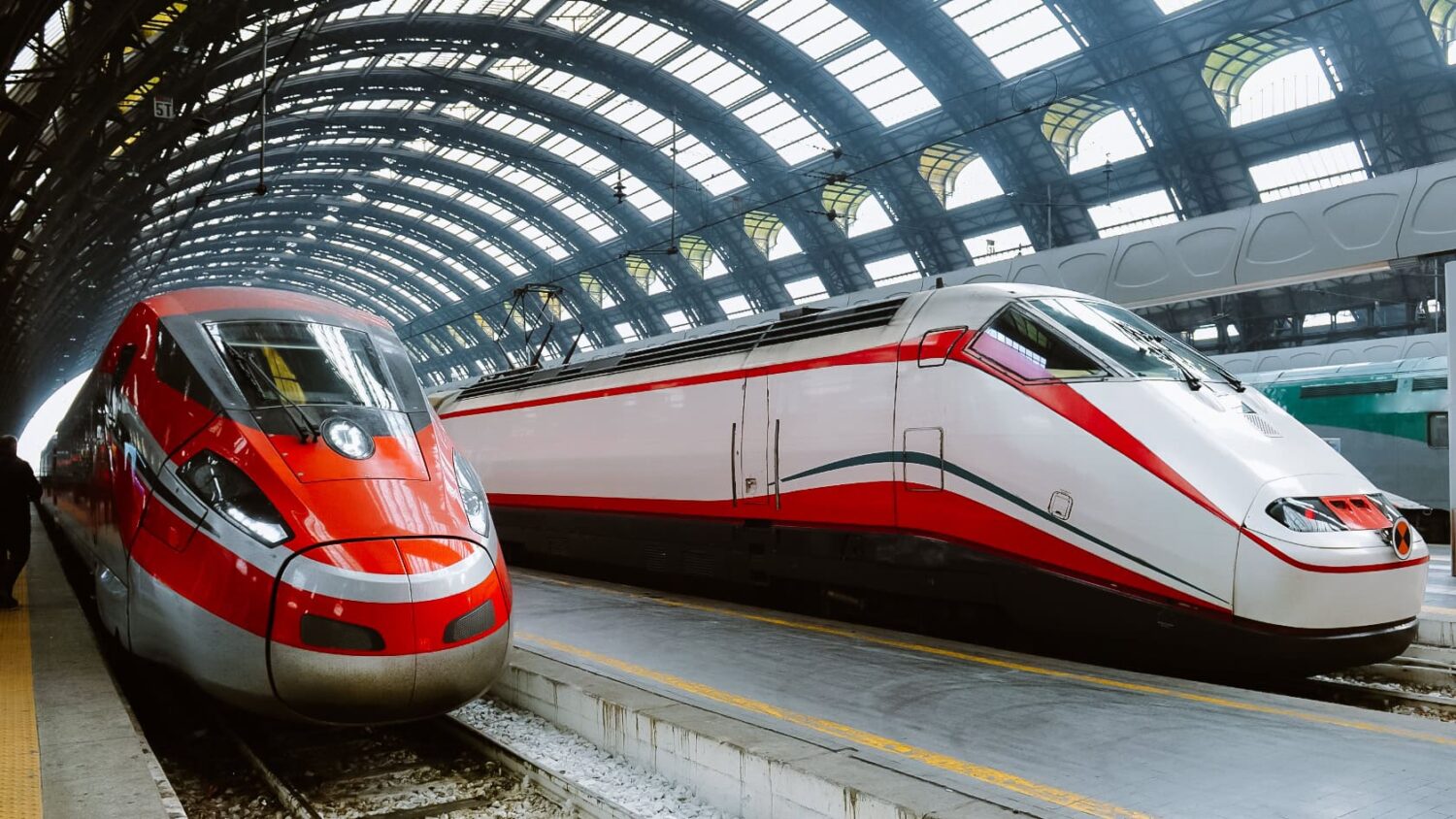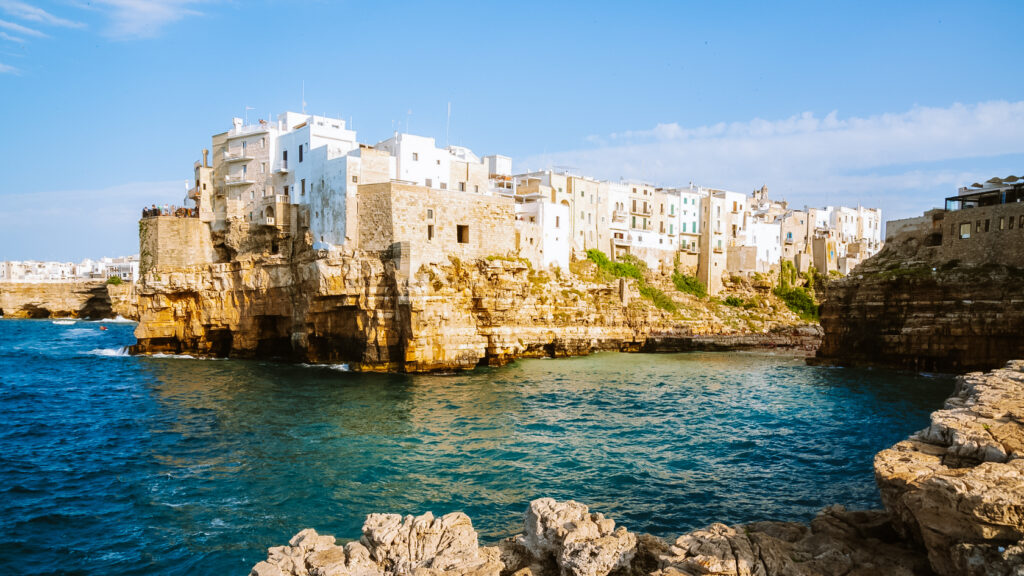Are you interested in travelling by train in Italy and looking for more information? We’ve put together a detailed guide with our experiences on how to travel by train in Italy, what to look out for, where to buy tickets and other useful tips.
Italy offers excellent train connections – trains are modern, on time and the rail network covers the whole country, from densely populated urban areas to remote rural regions. This makes it easy to get where you need to go.
If you have experience travelling by train in the Czech Republic, travelling by train in Italy will be a breeze for you. Let’s take a closer look.
☞ We love travelling by train, that’s why we have put together 5 sample itineraries for where to go in Italy by train (including maps and useful information).
Travelling by train in Italy
Train types and classes
In Italy, you can choose from different types and classes of trains to suit your needs:
- Regional trains (Regionale): these trains are basic and affordable, suitable for short journeys and connections between smaller towns. On the other hand, they take considerably longer and are more often delayed than high-speed trains.
- Intercity trains (InterCity): offer faster connections between major cities with the possibility of booking a seat.
- High-speed trains (Frecciarossa, Frecciargento, Italo): they are the fastest and most comfortable, with first-class services such as wi-fi, comfortable seats and refreshments.
What services do trains provide in Italy?
Regional trains are no different from regional trains in the Czech Republic – they are comfortable and there are no toilets.
High-speed trains also include snack and drink vending machines, and Trenitalia’s Frecciarossa and Frecciargento trains even have their own first-class bistro. The seats are comfortable, have type C sockets and there are electric boards with information about the train (next stop, train speed, etc.).

High-speed trains
High-speed trains in Italy are great for travelling longer distances. Two hours from Venice to Florence, an hour and a half from Florence to Rome and an hour and a quarter from Rome to Naples. In a short time, you can travel through several Italian cities that are among the most beautiful in Europe and the world.
If you are travelling with high-speed trains, you have the following train operators to choose from:
- Italo
- Trenitalia (Frecciarossa and Frecciargento)
We have traveled with both and I don’t see much difference between them. Both carriers offer great service, a wide choice of connections and similar prices. So I recommend to make a decision based primarily on price and time.
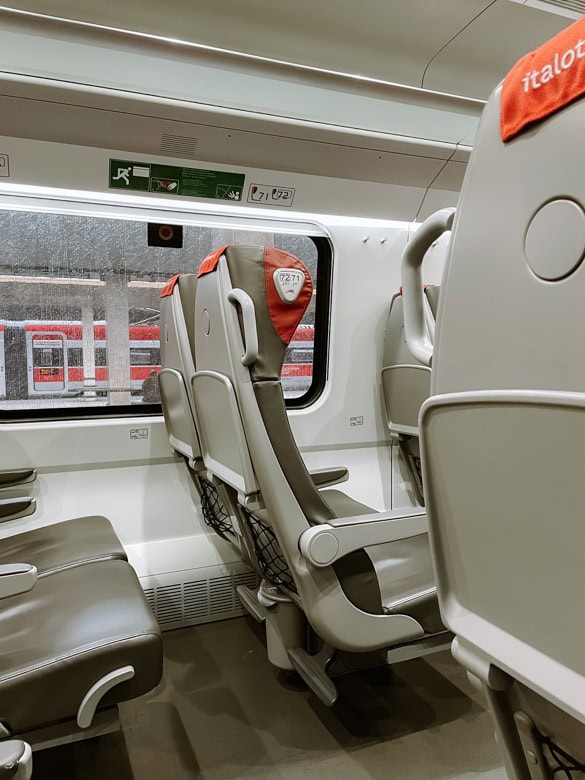
Tip: Whether you travel with Italo or Trenitalia (Frecciarossa and Frecciargento trains), It’s a good idea to buy your ticket in advance. A few days in advance are the best prices and they increase by a few euros closer to the departure date. If you book well in advance, you get a trip 1st class for the price of 2nd class. In addition, some dates and times may be sold out.
We have the dates and now you choose the class you want to travel in. The final price varies from there. The standard class is called Smart for Italo and Standard for Trenitalia. Both carriers also offer a first class ride, which is a few euros more expensive.

Tickets on high-speed trains
When you buy your ticket, you will also be assigned a seat (or you can choose one yourself). On the ticket you will see the car number (Carrozza – Coach) and the seat number (Seat) – for example Coach 6 and Seat 72. The trains have the car number clearly marked on the carriage and there are also electric boards at the larger stations where the car numbers are also marked.
Travelling by train in Italy is very easy – not like with Czech Railways, where you have to look for a 3-digit carriage number at the last minute. 🙂 Thanks to electric signs in Italy, you can stand exactly where your car stops.
Here you can find all train connections within Italy, so you can compare prices and buy everything in one place – just enter where you’re travelling from and to. Once entered, you will get all connections for the selected day.
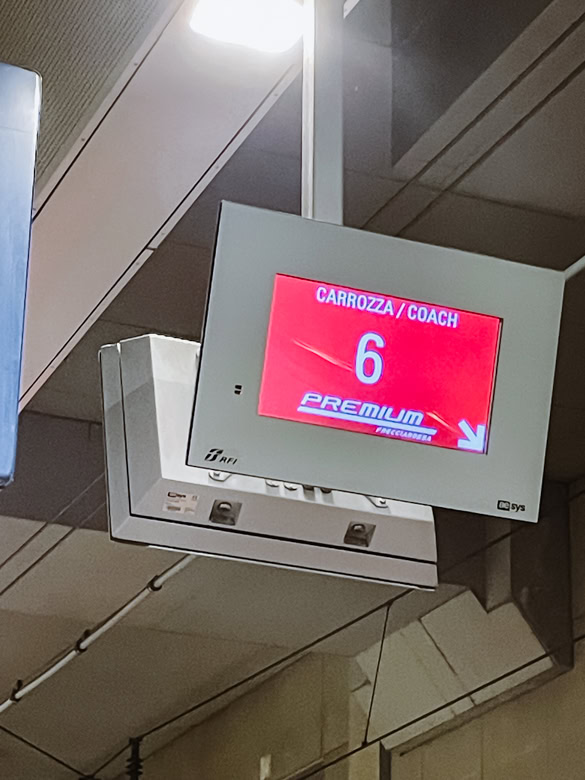
Buying tickets for train travel in Italy
You can purchase tickets in several ways:
- Online: Online purchase often allows you to get better prices, especially if you book your tickets well in advance (especially for high-speed trains).
- At the station: Tickets can also be bought directly at train stations, either at ticket offices (look for Biglietteri) or at ticket machines. This is handy if you are travelling shorter distances or if your plans are flexible.

Ticketing through the machines is very intuitive, with a choice of languages (Italian, English, Spanish, German, French and others). There are machines at the station separately for Italo and Trenitalia – they clearly indicate which carrier they are.
For regional connections, just buy tickets on the spot at a ticket shop or ticket machine. For high-speed trains, it’s better to book in advance to get a better price and secure your seat.
Discounts on fares
Trenitalia and Italo provide fare discounts. These discounts may also vary depending on the region you are travelling in.
In general, however, children up to 4 years of age (up to 3 years in Italo) often travel for free, or up to 6 years in some regions. Italo also offers discounts for young people and senior discounts for passengers over 60 years of age (ID required). Both carriers provide discounted fares for families.
The discount will be automatically loaded after all passengers have been entered.
☞ Here it is 5 sample itineraries for where to go in Italy by train (including a map and useful information).
How is train travel in Italy?
We’re arriving at the station. If you don’t have a ticket, look for a Biglietteria ticket shop or a ticket machine where you can buy a ticket.
You will have the number of the connection marked on your ticket, which you can then look up on the departure boards (marked Partenze). In addition to the connection number, you will also see the departure time, destination and platform number(Binario) on the board. At smaller stations, there are only paper timetables instead of electronic boards.
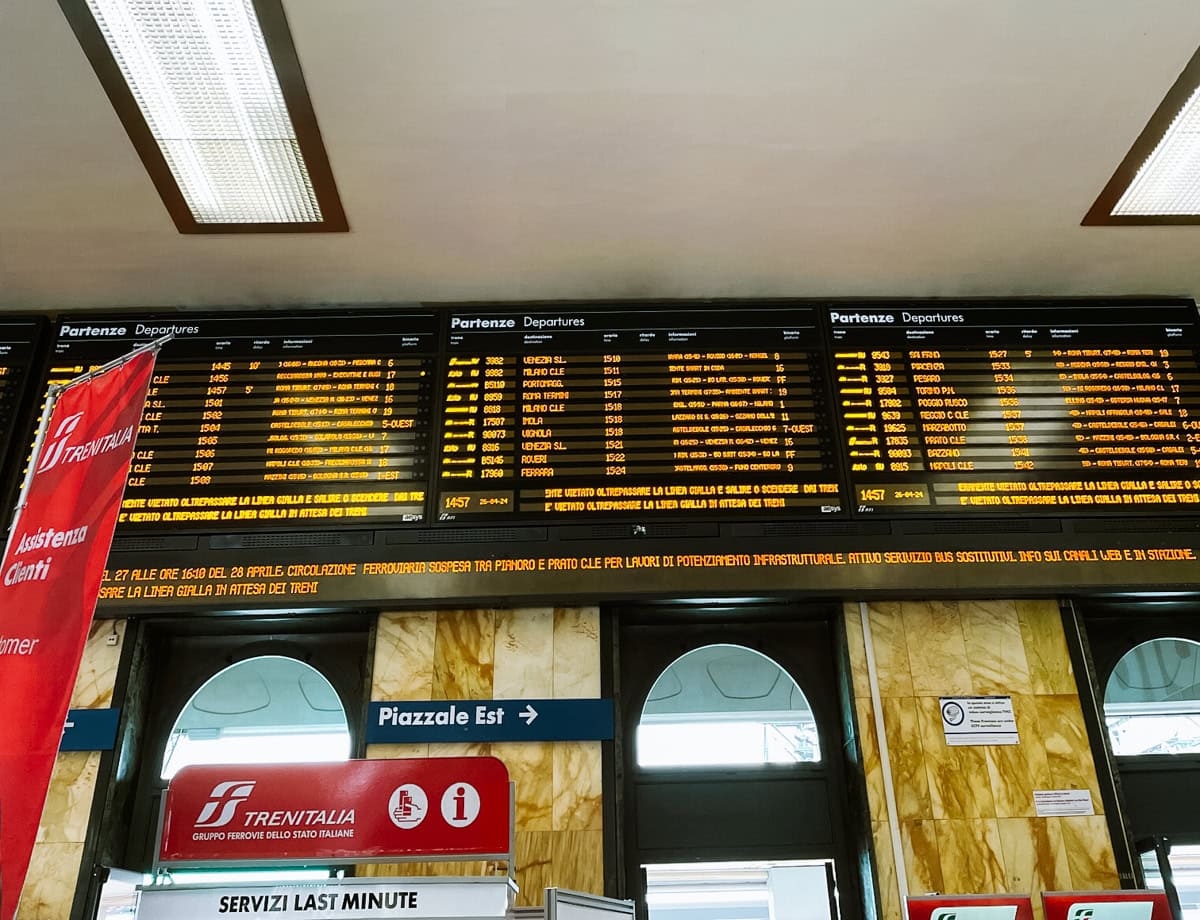
When the platform number is published, go to the train. On the platform, check that your connection leaves from there just in case. There are small departure boards that provide all the information you need.
Just beware that sometimes multiple trains can depart from one platform within a few minutes of each other. This applies to Bologna station, for example – but again there is a departure board where you can check your connection.
Arrive early as it sometimes takes a while to get to the platform. In Florence, for example, the platforms are right by the lobby, but in Bologna you walk longer, sometimes a few floors down (depending on the platform number).
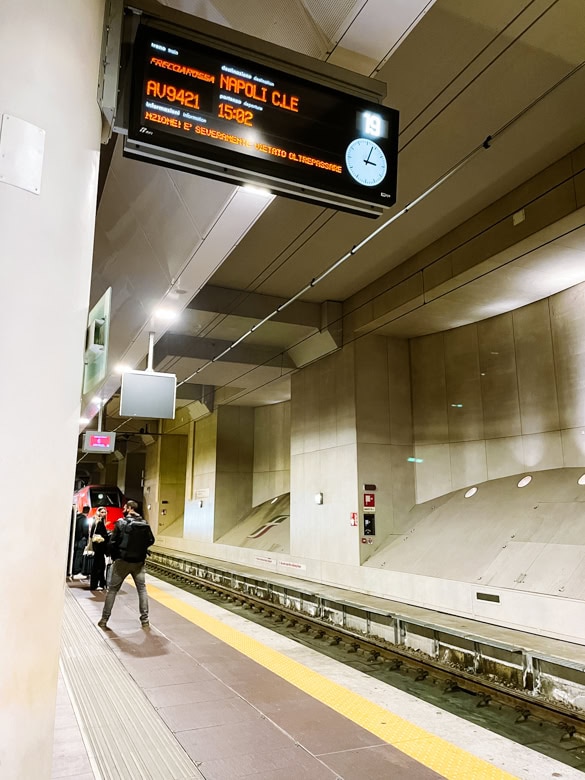

To mark or not to mark a ticket before boarding?
If you bought only a regional ticket, you must mark it in the small green turnstile on the way to the platform. The ticket is valid for the whole day, so you need to mark a specific time. If you don’t mark your ticket and an inspection comes, you will pay a heavy fine.
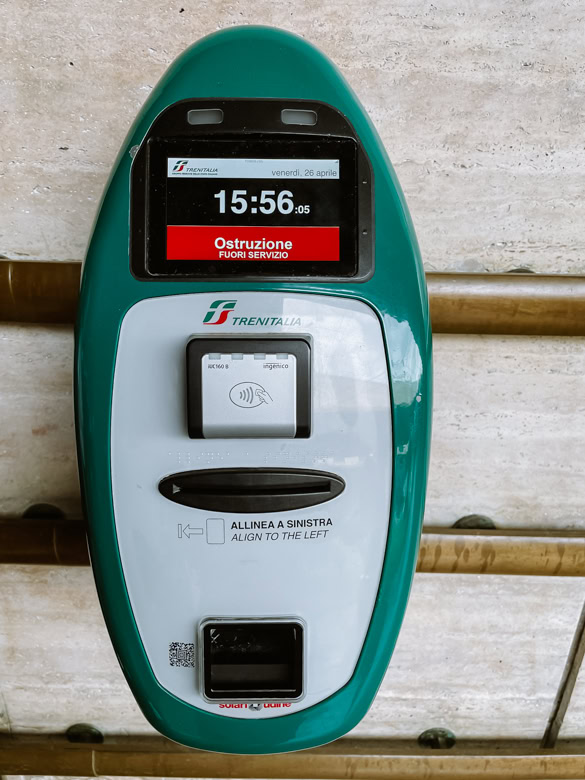
This does not apply to express trains, where you buy a ticket for a specific connection, so you no longer need to mark it.
With a regional ticket you can sit anywhere – no seat ticket is included. For express trains, you look up your carriage and seat number (everything is well signposted).
Here you can find all train connections within Italy, so you can compare prices and buy everything in one place – just enter where you’re travelling from and to. Once entered, you will get all connections for the selected day.
This was our guide and tips for train travel in Italy. Do you have a question? We’ll be happy to answer it in the comments below. Have a safe journey!
More information about Italy
ITALY: Get inspired by the most beautiful places in Italy or visit northern Italy. We’ve put together 5 sample itineraries of where to go in Italy by train (including maps and useful information).
ITALIAN CITIES: here’s a list of the most beautiful places in Rome. We have also created a detailed itinerary for 3 days in Rome. Or head south to Naples. Are you tempted by fashionable Milan? Enjoy your stay in this 3-day itinerary in Milan.
TUSCANY: Get inspired by the most beautiful places in Florence. Are you planning to explore the whole of Tuscany? We’ve put together our tips for what to see in Tuscany, including a map. Here are the best places to visit in Pisa.
NORTHERN ITALY: Here is the itinerary and route map for 2 days in Venice. See the most beautiful places to visit in Verona. Or enjoy a wonderful holiday at Lago di Garda. Get inspired with tips on sights and attractions to visit in Bologna.
